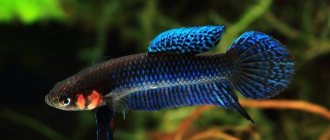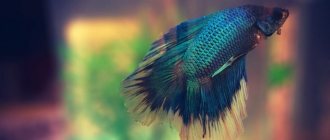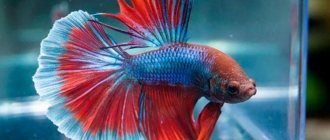The betta fish is a representative of the labyrinth variety. It performs a decorative function in aquariums. Males have quite a stormy character, they are even involved in fighting tournaments in Asian countries. Most often, fish can be bought at a pet store. Below is a price table for betta fish:
- Average cost of cockerel fish: 320-400 rubles per 1 piece;
- In an aquarium: 1400-1600 rubles ;
- Rare breeds: 500-750 rub/piece .
To understand pricing, you should also consider the following factors:
- Kinds;
- Places of sale.
General information
Betta fish belong to the suborder Labyrinth fish. Their peculiarity is the presence of a special respiratory organ called a labyrinth. This organ is represented by plates densely penetrated with blood vessels and is located in the accessory epibranchial plane. Thanks to it, bettas can use atmospheric air to breathe. This type of breathing is vital for aquarium bettas, so keeping them in a closed vessel, even well saturated with oxygen, leads to the death of the fish. The labyrinth appeared among cockerels as an adaptation to living in reservoirs poor in oxygen.
The betta is called a fighting fish because of its strong intraspecific aggression and territoriality.
Betta fish are extremely unfriendly with each other, and very often a collision between two males leads to the death of one of them. This feature has been used since ancient times by the residents of Thailand to conduct tournament fights for money. In some provinces this tradition is still alive.
Interesting training methods are used to prepare cockerels for tournaments. To increase stamina, the cockerel is placed in a tall bottle and forced to swim up and down for a long time. A mirror is moved along the glass, in which the betta can see its reflection. Creating a whirlpool in a round vessel also allows the cockerel to develop its strength. The fighting technique is perfected when the cockerel is placed with younger, weaker males.
Despite the ferocity of the clashes, “cockfights” are not without nobility. A male cockerel will never attack an opponent while he rises to the surface to swallow another portion of air. Also, if three males intersect in one place, the third does not interfere in the fight of the other two, but prefers to fight with the winner.
Veiled cockerel
Veiled cockerel-
aquarium fish veil cockerel
Veil fish
-
cockerel
(betta, Siamese cockerel, Betta splendens) - these are incredibly bright exotic fish that belong to the macropod family. This is a labyrinthine aquarium fish that also uses atmospheric air for breathing.
Cockerels have very interesting and varied colors, where all the colors of the rainbow can be present. Males are brighter colored than females.
The fish are small in size: males are about 5 cm, and females are 4 cm.
Differences between the sexes: Females are paler, smaller than males, with short fins.
Content:
Aquarium - from 3-10 liters for one pair; better 60-100 liters per male and group of females. Males can be kept separately in very small vessels. Females get along well in a group. Hardness 2-12°, up to 20°, pH 6.0-7.5. Depending on the breeding line, they can withstand temperatures up to 18-20°C, but it is better not to lower it below 24°C (this is especially true for long-finned forms and imported fish from Southeast Asia. For them, the optimal temperature is 24-30°C, but you can and above - up to 35°C). Access to the surface of the water to breathe atmospheric air is required.
Feeding:
Omnivores, prone to gluttony and obesity. The feed should not be too large, because If the fish choke, it may suffocate.
Compatibility:
Males cannot tolerate the presence of an opponent, and fights usually end with plucked fins and, in small quantities and lack of shelter, with the death of the weaker one. In a community aquarium, bettas live well with any peaceful, medium-sized fish. Sometimes males mistake fish of another species with long fins for rivals, so it is better not to keep them with veiled fish (for example, guppies).
Life expectancy in an aquarium is 3 years.
Cockerels can be kept either separately in small aquariums from 3L to 20L without filtration and aeration, or in large aquariums with a weak current; they can live quite peacefully with any peaceful fish without veil-shaped fins, provided that the aquarium is not overcrowded and the size is preferably from 30L - 50L .
Cannot be kept with barbs, some types of catfish, as well as with predatory fish species.
Bettas are an excellent choice for both beginners and professional aquarists.
In our retail store in Kazan you can purchase aquariums for betta fish wholesale and retail at the lowest prices.
Available are round, rectangular, rectangular aquariums with a partition for keeping several males at once, nano cube aquariums, aquariums in the form of a glass on a leg.
Our retail store in Kazan sells different types of cockerels from the simplest to the elite and collectible:
Veil, Two-tailed, Spear-tailed, Crown-tailed, Flag-tailed, Delta, Superdelta, Half Moon, Half Moon Dumbo (elephant-eared) poster, Half Moon Dumbo (elephant-eared) veil, Chinese dragon, Royal, etc.
Appearance
The body shape of cockerels is oval, it is elongated in length and slightly flattened on the sides. Betta is a small fish. The average length is 5-6 cm, with females being smaller.
The pectoral fins are pointed, while the dorsal and caudal fins are rounded. Male betta fish have more developed fins than females. Upper mouth. Natural coloration is usually dark brown with rows of shiny green spots, but in the aquarium the richness of color of these fish is unparalleled. The color of the scales of cockerels can change depending on environmental conditions: during spawning or skirmishes with other males, the color intensity increases, and during rest it weakens.
Modern breeders have bred more than 70 breeds of betta fish, differing in color and shape of fins. In aquariums you can find various variations of black, emerald, blue, red, pink and white tones. You can often observe how the scales of cockerels play and shimmer when moving and in bright light.
Depending on the shape and size of the fins, there are about ten varieties of aquarium bettas. For example, crown-tailed, delta-tailed, double-tailed and many others.
Types and price of cockerel fish
This fish is classified into the following varieties:
- ordinary. It has an elongated, narrowed body shape and feeds on insects. The fins have different shapes and lengths, and the distinguishing feature is dark brown scales with green spots. The average length of one individual is 6 cm. They are the most common option and are sold in pet stores for 240-270 rubles/piece ;
- black. It lives in Thailand and Malaysia, but is also bred by amateurs in Russia. It has a medium length and a variety of colors (black, red, blue). It can be distinguished in stores by its rounded shape, and the price tag in Moscow is 350-380 rubles ;
- red royal. A crown-tailed fighting breed that does not like to be near other fish. It has bright red scales and is popular due to its special color (red). One of the most expensive types of fish is cockerel, sold for 320-330 rubles ;
- Blue Siamese. It has a rich blue color and a veil-like fin. It has a red stripe on the side. It is mainly used for decorative purposes, and you can buy it for 290-320 rubles per piece;
- green. A wild species common in Asian waters. It has an elongated body with an olive green color. The fins shimmer in different colors: blue, green, red. Females are distinguished from males by lines on their backs. Cost 340-360 rubles .
You can get information on the types and find out how much cockerel fish costs in specialized stores.
History of appearance
At the beginning of the 19th century, residents of Siam (modern Thailand) began to pay attention to nondescript fish, which were distinguished by extremely aggressive behavior towards their relatives. They began to be regularly used to organize fights for money, which prompted particularly enterprising residents to crossbreed wild bettas. The fish obtained in this way were called Pla Kat, which translated means “biting fish.” Some of the most successful specimens were presented to the King of Siam and lived in his palace.
In 1840, the King of Siam presented several valuable specimens of cockerels to the Danish doctor and naturalist Theodor Cantor. In his scientific writings, Dr. Cantor assigned the new species to the genus Macropodus. However, already in 1909, the world famous ichthyologist Charles Tate gave the species a new name - Betta splendens. Most likely, the genus name is a reference to the militant Bettah tribe that existed at that time, and the species name is a modified “splendid” (beautiful, beautiful).
The first Europeans to see cockerels were the French and Germans. A little later, in 1910, the fish came to the USA. It was brought here by Frank Locke, who became one of the first breeders to obtain a new color variation of the aquarium betta (although he mistakenly called it a new species - Betta cambodia).
The appearance of the betta fish in Russia is associated with the names of domestic aquarists V.M. Desnitsky and V.S. Melnikova. The first of them brought an extensive collection of exotic fish from Singapore, and the second, at the beginning of the 20th century, was the first in the country to breed a whole range of labyrinth fish. A prestigious competition for the best fighting fish was named in his honor.
Habitat
The homeland of the cockerel is Southeast Asia. This is where inconspicuous natural forms live, which can be found in slowly flowing or stagnant bodies of water in Thailand, Cambodia, Laos, Vietnam, Indonesia and the Malay Peninsula. Bettas are found everywhere in the turbid, oxygen-poor waters of rice fields, and often even in the drains of large cities. An additional respiratory organ, the labyrinth, helps the cockerels survive in such extreme conditions.
Selected forms of cockerels have become real cosmopolitans. They can be found in hobbyist aquariums around the globe. Local and international exhibitions and competitions are held on a regular basis, where you can meet the most unusual and striking representatives of the aquarium betta.
Breeds of betta fish
Due to the fact that breeders around the world have bred a huge number of forms of bettas that differ significantly from each other, there is a certain confusion among aquarists regarding the use of the word “species”. All modern aquarium bettas, no matter how different their body color and fin structure may be, are varieties of one species - Betta splendens, therefore it is correct to call them breeds, not species.
It is worth noting that in the genus Betta there are several species of bettas, for example, Betta smaragdina or Black cockerel (Betta imbellis), which, unlike their closest relative, are relatively peaceful fish. These species can be kept in groups and can often interbreed with Betta fish. Some members of the genus Betta do not build a bubble nest, but prefer to carry their young in their mouths.
Modern breeds of aquarium bettas are classified according to two characteristics: the color of the scales and the shape of the fins. A special group includes giant or royal fighting fish (distinguished by their large size) and bettas with the “Dragon” coloring (large body and a large number of silver-metallic shades on the scales, like chain mail).
Cost of cockerel fish in stores
Since this fish is quite popular, it can be found in various retail outlets. The most popular are the following:
- Pet stores. You can inspect the aquariums and choose any individual you like. There are usually several breeds in stock. There is even the opportunity to choose the shade that you like best. At the same time, the buyer can take literature on aquarium care, and also purchase several kilograms of food. The price tag is 340-380 rubles .
- Markets. Mostly, the fish offered for sale here are fish that the sellers raised themselves. Some of them purchase these pets from suppliers. Any required individual or enough kg of feed can be supplied upon order. Buy a pet here for 290-320 rubles / piece .
- Private owners. Most breeders have higher prices than anywhere else. In addition, they have a much smaller selection; they mainly offer 1-2 breeds. But it is still possible to order even the rarest variety. As a rule, private traders offer goods for 270-320 rubles .
The betta is a popular aquarium fish that is very popular. Many people breed it on an industrial scale. Its prices are quite affordable.
Subscribe to our channel in Yandex.Zen
Care and maintenance
Many hobbyists began their first steps in aquarium keeping with the purchase of a betta fish. This is due to the amazing endurance of the betta, the ability to keep it in small aquarium volumes (from 3 liters) and the lack of need for aeration. However, keeping a betta in an aquarium should take into account some of the characteristics of this fish.
First of all, you need to decide on the volume and configuration of the aquarium for your betta. The most suitable option would be a classic rectangular aquarium with a volume of 20 liters or more. It will have sufficient volume for a betta fish to live comfortably, and will also allow you to install and decorate all the necessary equipment. Keeping cockerels in round aquariums is very popular. Disadvantages of such containers: small volume, difficulties with equipment installation and maintenance, distortion through convex glass. If the desire to have a round aquarium with a cockerel is very strong, it is recommended to buy branded round aquariums with built-in equipment (they have the necessary set of equipment for the life support of the fish, as well as an attractive design). In small aquariums, you can keep only one male betta and, if desired, several females. If you plan to keep several males, then you need to place them in an aquarium of at least 100 liters with plenty of vegetation and shelter, or use a special plastic partition with holes for water circulation. You should not keep cockerels in pairs; in this case, an active male may kill a female that is not ready for spawning. The aquarium should be covered with a lid or net to prevent the betta from jumping out of it. In this case, female bettas can be kept in groups in one aquarium.
It is best to use dark soil; it is advisable to place it in a layer of 2-3 cm; with such gravel, betta fish look the most impressive and contrasting.
Aquarium bettas are heat-loving fish; the comfortable temperature for them is 24-26°C. It is noted that the higher the water temperature, the brighter the color of the bettas. The optimal parameters for hardness and acidity are 2-12° and 6.0-7.5, respectively. As already mentioned, the presence of aeration in an aquarium for bettas is not necessary, but it is important that there is gas exchange with the surface of the water. It is highly recommended to install a filter in the aquarium, which will allow the water to remain clear (mechanical cleaning) and safe (the likelihood of accumulation of toxic ammonia and its derivatives will be reduced). It is necessary to change 25-30% of the water weekly; in very small aquariums it is recommended to do changes more often - 2-3 times a week.
The most comfortable temperature for a betta is 24-26° C
The presence of live plants in an aquarium with bettas will have a positive effect on water parameters.
In addition, the plants will serve as natural shelters for the inhabitants of the aquarium. When installing artificial plants or decorations, you must pay attention to the absence of sharp edges that could damage the delicate fins of fish.
Sometimes bettas allow their owners to pet them. You should not overuse this procedure, as you can accidentally damage the protective layer of mucus on the scales, which will make the fish more vulnerable to diseases.
Quite often, betta fish lie at the bottom of the aquarium or on their side near the surface. This usually frightens betta owners, but for these fish this behavior is typical and not dangerous. It is worth sounding the alarm only if such a phenomenon has been observed for a long time.
The average lifespan of a betta in an aquarium is 3 years.
Cockerels
The betta fish is one of the most colorful and fairly easy to keep aquarium fish. It has many color options and fin shapes. We like to surprise our customers, so we regularly bring new interesting breeds. You can buy a cockerel from us in Tyumen.
Betta imbellis, Betta samaragdina, Betta splendens, Betta coccina, Betta mahachaiensis, Betta macrostoma, Betta unimaculata, Betta taeniata.
This is not the entire list of species united by one common simple name - cockerel. These fish are native to southeast Asia. In the past, they were kept by humans for male-male fighting. Currently, very beautiful breeds have been bred through selective breeding. The most common and popular in Russia are:
- Siamese veiled cockerel (veiled cockerel),
- crown-tailed cockerel,
- cockerel half moon,
- Koi Betta, Dumbo and Superdelta.
They all belong to variations of the same species, Betta splendens .
Due to the fact that all fish of this family have a labyrinthine organ that allows them to breathe air from the surface of the water, they have become very popular all over the world. After all, a small volume of water is enough to maintain them and no expensive equipment is required.
Based on our own many years of experience in keeping bettas, we nevertheless came to the conclusion that with filtration and aeration of the water in the aquarium, they seem to blossom: their fins become lush, their appetite increases noticeably, and their life expectancy is extended. We also do not recommend keeping males in containers smaller than 5 liters. Another important condition for keeping male bettas is to separate them from individuals of their own species, or from similar veiled fish, they are very aggressive towards them, can severely injure them and even kill them. Each cockerel has a distinct character and varying degrees of aggression. In large aquariums without females, more than two males can coexist; their meetings rarely end in fights. Usually the more aggressive male simply drives the competitor out of his territory.
In small containers without equipment, it is desirable to have live plants, such as hornwort . In bright light during the day, plants undergo the process of photosynthesis, while carbon dioxide and excess toxic nitrogen compounds are consumed from the water. You can feed your betta with specialized dry and frozen food once or twice a day. For example, Tetra Betta Larva Stiks with small bloodworms and well-processed tubifex. Once a week you can have a fasting day.
In our Aquamir salon we always have cockerels of different breeds and colors in stock, as well as everything necessary for their maintenance. We will be happy to advise you in detail on the compatibility, maintenance and feeding of these beautiful fish.
Compatibility
The cocky nature of aquarium bettas does not mean at all that the path to keeping them in a common aquarium with other fish is completely closed. There are several groups of fish based on their compatibility with bettas:
- Species that get along well: viviparous platies, corydoras, thornets, rasboras, irises.
- Species that get along, but can pinch fins: barbs, angelfish, neons, minors.
- Completely incompatible species: large cichlids, piranhas, tetraodons, goldfish.
It is important to remember that keeping bettas with other species is only possible in an aquarium of the appropriate size. When introducing a betta into a community aquarium, it is necessary to carefully observe the behavior of the betta. If other fish encroach on the fins, or the betta itself attacks some of the inhabitants, it is recommended to put it in a separate container.
The proximity of betta fish and species with long veil fins or bright colors is extremely undesirable - they can most often suffer from an attack by a betta.
Females behave more calmly; they rarely have problems keeping with other fish of suitable size.
Sales points and cost
You can buy cockerel fish in various establishments, such as:
- pet stores. You can choose any fish you like in the aquarium. The assortment includes various species, as well as young fish. It is also possible to choose a color. Along the way, you can buy the relevant literature and get competent advice on breeding and growing. The average cost of one individual is 240-260 rubles per piece;
- Markets. The market offers products from small private owners and small companies for breeding ornamental fish. The average check will be 210-230 rubles . You can choose the option you like or supply the variety you are interested in to order. You can find the necessary retail outlets at any festival or flea market;
- private owners. Buying aquarium fish from private owners will cost more ( 190-220 rubles ) than in a pet store, and they also offer significantly less choice when prices are 20-30%. The main advantage is the ability to order even the rarest variety, which will be delivered upon special request.
This information will be useful for both beginner aquarium hobbyists and experienced ones to understand the price of betta fish.
Feeding betta fish
The basis of nutrition for bettas in nature are aquatic insects and their larvae, zooplankton. Betta fish do not disdain individual algae. When kept in an aquarium, problems with feeding these fish usually do not arise. The best basic foods are complete dry foods from Tetra. The company's specialists have developed special food for betta fish that meets their nutritional needs - the Tetra Betta series:
- Tetra Betta is a high protein flake food thanks to the addition of shrimp and krill. Also contains natural enhancers of natural body color.
- Tetra Betta Granules are a balanced food for bettas and other labyrinths in the form of attractive floating granules. High protein levels, natural color enhancers ideal for bettas. The food contains a large amount of vitamins and nutrients that will help strengthen the immune system of your bettas.
- Tetra Betta LarvaSticks is a complete food in the form of granules that imitate insect larvae. The sticks are selected in such a way that it is convenient for the cockerels to swallow food. High digestibility improves water quality with regular feeding. Natural color enhancers make the body color of the fish bright and rich.
To add variety to the feeding process for bettas, you can use Tetra FreshDelica treats - popular food organisms in nutritious jelly, or Tetra FunTips Tablets - highly nutritious tablets that can be easily attached to the glass of the aquarium and allow you to observe with what pleasure the fish eat them.











